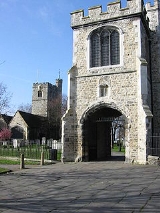
Barking Abbey
Encyclopedia
The ruined remains of Barking Abbey are situated in Barking
in the London Borough of Barking and Dagenham
in east London
, England, and now form a public open space.
, for his sister Saint Ethelburga in 666, as a missionary centre. All Hallows Barking
, at Tower Hill
, was founded by the abbey in 675.
One of the great early works of Anglo-Latin scholarship, the De Laude Virginitatis ("In Praise of Virginity"), a double (prose and verse) work in the complex Latin style taught at the Canterbury School of Adrian of Canterbury
praising Christian martyrdom and spiritual virginity, was dedicated by its author Saint Aldhelm (d. 709) to the ladies of Barking.
Bede
recorded the foundation. The abbey was destroyed by the Vikings in 870, and 100 years later was re-established as a Royal foundation.
As overseer of the abbey, Queen Ælfthryth deposed the abbess Wulfida after complaints made by the nuns, but she reinstated her twenty years later.
William the Conqueror
spent his first New Year after the Norman Conquest in 1066 at the abbey. Archbishop Dunstan made Barking Abbey a strict Benedictine nunnery.
In November 1539 the abbey was dissolved by order of Henry VIII
. After that, the site was used as a quarry and a farm. A modern ward of the present borough is named Abbey after the ruin.
Barking
Barking is a suburban town in the London Borough of Barking and Dagenham, in East London, England. A retail and commercial centre situated in the west of the borough, it lies east of Charing Cross. Barking was in the historic county of Essex until it was absorbed by Greater London. The area is...
in the London Borough of Barking and Dagenham
London Borough of Barking and Dagenham
In 1801, the civil parishes that form the modern borough had a total population of 1,937; and the area was characterised by farming, woodland and the fishing fleet at Barking. This last industry employed 1,370 men and boys by 1850, but by the end of the century had ceased to exist; replaced by...
in east London
London
London is the capital city of :England and the :United Kingdom, the largest metropolitan area in the United Kingdom, and the largest urban zone in the European Union by most measures. Located on the River Thames, London has been a major settlement for two millennia, its history going back to its...
, England, and now form a public open space.
History
Dedicated at first to Saint Mary, and later to Saints Mary and Ethelburga, Barking Abbey was founded by Saint Erkenwald, Bishop of LondonBishop of London
The Bishop of London is the ordinary of the Church of England Diocese of London in the Province of Canterbury.The diocese covers 458 km² of 17 boroughs of Greater London north of the River Thames and a small part of the County of Surrey...
, for his sister Saint Ethelburga in 666, as a missionary centre. All Hallows Barking
All Hallows-by-the-Tower
All Hallows-by-the-Tower, also previously dedicated to St Mary the Virgin, is an ancient Anglican church located in Byward Street in the City of London, overlooking the Tower of London.-History:...
, at Tower Hill
Tower Hill
Tower Hill is an elevated spot northwest of the Tower of London, just outside the limits of the City of London, in the London Borough of Tower Hamlets. Formerly it was part of the Tower Liberty under the direct administrative control of Tower...
, was founded by the abbey in 675.
One of the great early works of Anglo-Latin scholarship, the De Laude Virginitatis ("In Praise of Virginity"), a double (prose and verse) work in the complex Latin style taught at the Canterbury School of Adrian of Canterbury
Adrian of Canterbury
Saint Adrian of Canterbury was a famous scholar and the Abbot of St Augustine's Abbey in Canterbury in the English county of Kent.-Life:...
praising Christian martyrdom and spiritual virginity, was dedicated by its author Saint Aldhelm (d. 709) to the ladies of Barking.
Bede
Bede
Bede , also referred to as Saint Bede or the Venerable Bede , was a monk at the Northumbrian monastery of Saint Peter at Monkwearmouth, today part of Sunderland, England, and of its companion monastery, Saint Paul's, in modern Jarrow , both in the Kingdom of Northumbria...
recorded the foundation. The abbey was destroyed by the Vikings in 870, and 100 years later was re-established as a Royal foundation.
As overseer of the abbey, Queen Ælfthryth deposed the abbess Wulfida after complaints made by the nuns, but she reinstated her twenty years later.
William the Conqueror
William I of England
William I , also known as William the Conqueror , was the first Norman King of England from Christmas 1066 until his death. He was also Duke of Normandy from 3 July 1035 until his death, under the name William II...
spent his first New Year after the Norman Conquest in 1066 at the abbey. Archbishop Dunstan made Barking Abbey a strict Benedictine nunnery.
In November 1539 the abbey was dissolved by order of Henry VIII
Henry VIII of England
Henry VIII was King of England from 21 April 1509 until his death. He was Lord, and later King, of Ireland, as well as continuing the nominal claim by the English monarchs to the Kingdom of France...
. After that, the site was used as a quarry and a farm. A modern ward of the present borough is named Abbey after the ruin.
External links
- Barking and Dagenham London Borough Council - Heritage and History, Barking Abbey
- Tudor Place - Barking Abbey
- Houses of Benedictine nuns: Abbey of Barking, A History of the County of Essex: Volume 2 (1907), pp. 115-122

